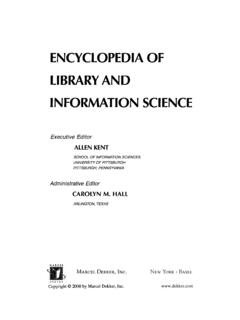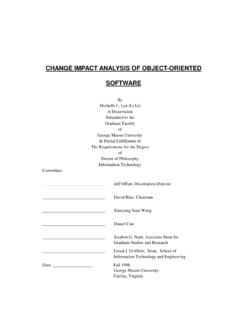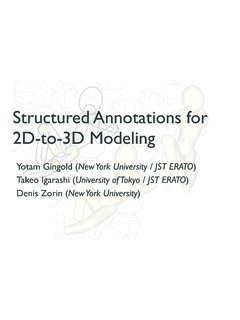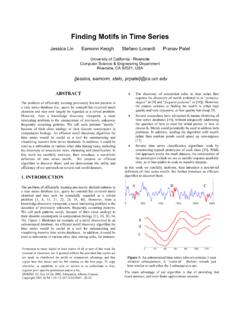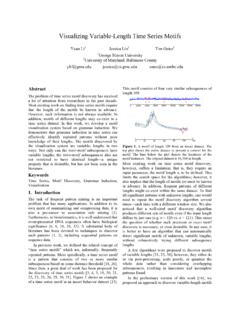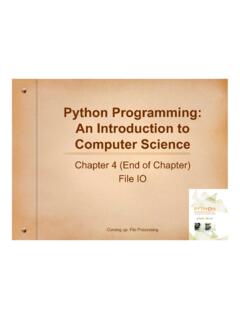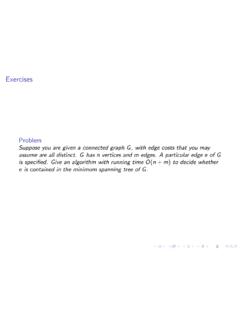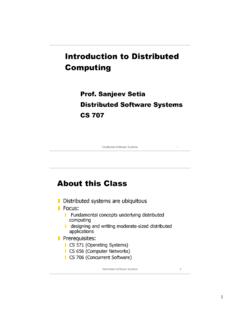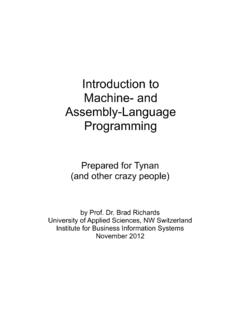Transcription of MIPS Instructions - George Mason University
1 1 1998 MorganKaufmannPublishersChapter 32 1998 MorganKaufmannPublishersMIPS Instructions InstructionMeaningadd $s1,$s2,$s3$s1 = $s2 + $s3sub $s1,$s2,$s3$s1 = $s2 $s3addi $s1,$s2,4$s1 = $s2 + 4ori $s1,$s2,4$s2 = $s2 | 4lw$s1,100($s2)$s1 = Memory[$s2+100] sw$s1,100($s2)Memory[$s2+100] = $s1bne$s4,$s5,LabelNext instr. is at Label if $s4 $s5beq$s4,$s5,LabelNext instr. is at Label if $s4 = $s5slt $t1,$s2,$s3 if $s2 < $s3, $t1 = 1 else $t1 = 0j LabelNext instr. is at Labeljr $s1 Next instr is in register $s1jal LabelJump and link procedure at Label3 1998 MorganKaufmannPublishers assembly provides convenient symbolic representation much easier than writing down numbers , destination first Machine language is the underlying reality , destination is no longer first assembly can provide'pseudoinstructions' , move $t0, $t1 exists only in assembly would be implemented using add $t0,$t1,$zero assembly language vs.
2 Machine Language4 1998 MorganKaufmannPublishers Instructions are bits Programs are stored in memory to be read or written just like data Fetch & Execute Cycle Instructions are fetched and put into a special register Bits in the register "control" the subsequent actions Fetch the next instruction and continueProcessorMemorymemory for data, programs, compilers, editors, Program Concept5 1998 MorganKaufmannPublishersInstruction Set Architecture: What Must be Specified?InstructionFetchInstructionDec odeOperandFetchExecuteResultStoreNextIns truction Instruction Format or Encoding how is it decoded? Location of operands and result where other than memory?
3 How many explicit operands? how are memory operands located? which can or cannot be in memory? Data type and Size Operations what are supported Successor instruction jumps, conditions, branches-fetch-decode-execute is implicit!6 1998 MorganKaufmannPublishersMIPS Design Principles Reduced Instruction Set Computers (RISC) design philosophy Principles guiding Instruction Set Design Smaller is faster Example: Only 32 registers in MIPS Simplicity favors regularity Good design demands compromise Make the common case fast7 1998 MorganKaufmannPublishers Instructions , like registers and words of data, are also 32 bitslong Example: add $t0, $s1, $s2 registers have numbers, $t0=9, $s1=17, $s2=18 Instruction Format:00000010001100100100000000100000o prsrtrdshamtfunct RFormatMachine language .
4 R Format8 1998 MorganKaufmannPublishers Consider the load-word and store-word Instructions , What would the regularity principle have us do? New principle: Good design demands a compromise Introduce a new type of instruction format I-type for data transfer Instructions other format was R-type for register Example:lw$t0, 32($s2)3518932oprsrt16 bit number Where's the compromise?Machine language : I format9 1998 MorganKaufmannPublishersMachine language : J Format Jump (j) , Jump and link (jal) Instructions have two fields Opcode Address Instruction should be 32 bits (Regularity principle) 6 bits for opcode 26 bits for addressop26 bit addressJ10 1998 MorganKaufmannPublishers simple Instructions all 32 bits wide very structured, no unnecessary baggage only three instruction formatsoprsrtrdshamtfunctoprsrt16 bit addressop26 bit addressRIJMIPS Instruction Formats11 1998 MorganKaufmannPublishersWhat about other Instructions slt $t0, $s1, $s2 3 operands all registers use R format beq$s1,$s2, Label 2 registers + address use I format addi$s1,$s1.
5 4 2 registers + immediate value use I format jr$t1 1 register R format12 1998 MorganKaufmannPublishersImplications of design choices Using I format for arithmetic Instructions with immediate operands Only 16 bits for immediate field Constants have to fit in 16 bits Using I format for branch Instructions Only 16 bits in immediate field But 32 bits needed for branch address J format Only 26 bits for address field But 32 bits needed for Jump address13 1998 MorganKaufmannPublishers Small constants are used quite frequently (50% of operands) , A = A + 5;B = B + 1;C = C -18; So in most programs, constants will fit in 16 bits allocated forimmediate field Design Principle: Make the common case fast Common case.
6 Constant is small Only need to use one instruction in the common case3 Constants14 1998 MorganKaufmannPublishers We'd like to be able to load a 32 bit constant into a register Must use two Instructions , new "load upper immediate" instructionlui$t0, 1010101010101010 Then must get the lower order bits right, ,ori$t0, $t0, 1010101010101010101010101010101000000000 0000000000000000000000001010101010101010 10101010101010101010101010101010ori10101 010101010100000000000000000filled with zerosHow about larger constants?15 1998 MorganKaufmannPublishers Instructions :bne$t4,$t5,LabelNext instruction is at Label if$t4 $t5beq$t4,$t5,LabelNext instruction is at Label if $t4 = $t5j LabelNext instruction is at Label Formats: Addresses are not 32 bits How do we handle this with load and store Instructions ?
7 Oprsrt16 bit addressop26 bit addressIJAddresses in Branches and Jumps16 1998 MorganKaufmannPublishers Instructions :bne$t4,$t5,LabelNext instruction is at Label if $t4 $t5beq$t4,$t5,LabelNext instruction is at Label if $t4=$t5 Formats: Could specify a register (likelwandsw) and add it to address use Instruction Address Register (PC = program counter) most branches are local (principle of locality) Jump Instructions just use high order bits of PC address boundaries of 256 MBoprsrt16 bit addressIAddresses in Branches17 1998 MorganKaufmannPublishersAddressing in branches Immediate field is 16 bits but we need an address that is 32 bits Obtain address using PC-relative addressing On branch, new PC = PC + immediate field in branch instruction Actually, new PC = (PC+4) + immediate field in branch instruction80000 Loop.
8 Mult $9, $19, $1080004lw $8, Sstart($9)80008bne $8, $21, Exit80012add $19,$19,$2080016j Loop80020 Exit:5 8 21 2op rs rt addressI formatImmediate field contains thedistance in words between PC+4and branch target address18 1998 MorganKaufmannPublishersUncommon Case for branches beq$18, $19, L1 replaced bybne$18, $19, L2j L1L2: Make the common case fastone instruction for most branches19 1998 MorganKaufmannPublishersAddressing in Jumps J format has 26 bits in address field How to get 32 bits? Assume that jump address is a wordaddress 26 + 2 (least significant bits) = 28 Get 4 most significant bits from PC 4 + 26 + 2 = 32 Implication: can only jump within a 228= 256 MB block of addresses Loader and linker must be careful to avoid placing a program across an address boundary of 256 MB20 1998 MorganKaufmannPublishersTo summarize:MIPS operandsNameExampleComments$s0-$s7, $t0-$t9, $zero,Fast locations for data.
9 In MIPS, data must be in registers to perform 32 registers$a0-$a3, $v0-$v1, $gp,arithmetic. MIPS register $zero always equals 0. Register $at is $fp, $sp, $ra, $atreserved for the assembler to handle large [0],Accessed only by data transfer Instructions . MIPS uses byte addresses, so230 memoryMemory[4], ..,sequential words differ by 4. Memory holds data structures, such as arrays,wordsMemory[4294967292]and spilled registers, such as those saved on procedure assembly languageCategoryInstructionExampleMeanin gCommentsaddadd $s1, $s2, $s3$s1 = $s2 + $s3 Three operands; data in registersArithmeticsubtractsub $s1, $s2, $s3$s1 = $s2 - $s3 Three operands.
10 Data in registersadd immediateaddi $s1, $s2, 100$s1 = $s2 + 100 Used to add constantsload wordlw $s1, 100($s2)$s1 = Memory[$s2 + 100]Word from memory to registerstore wordsw $s1, 100($s2)Memory[$s2 + 100] = $s1 Word from register to memoryData transferload bytelb $s1, 100($s2)$s1 = Memory[$s2 + 100]Byte from memory to registerstore bytesb $s1, 100($s2)Memory[$s2 + 100] = $s1 Byte from register to memoryload upper immediatelui $s1, 100$s1 = 100 * 216 Loads constant in upper 16 bitsbranch on equalbeq $s1, $s2, 25if ($s1 == $s2) go to PC + 4 + 100 Equal test; PC-relative branchConditionalbranch on not equalbne $s1, $s2, 25if ($s1 !)

